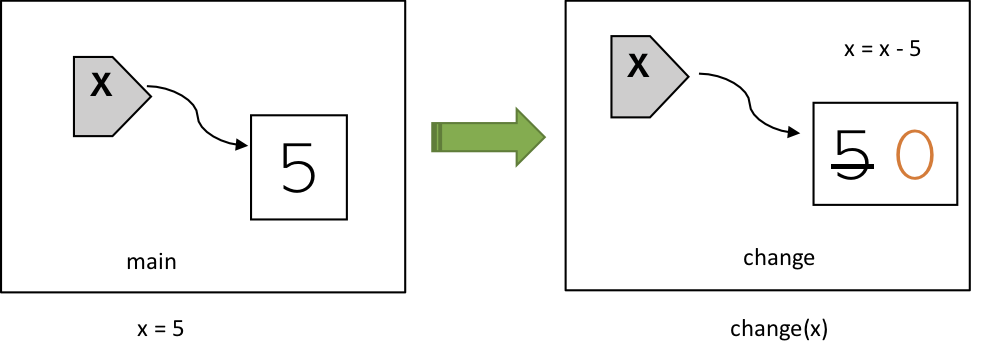If you have been following this R Functional Programming (RFP) series1, you know by now we have discussed:
In summary, we have the following facts about the R language:
- Variable assignment binds symols to objects.
- Reassignment changes the binding. It doesn’t modify data.
- Mutability is a property of objects. It has nothing to do with variables or variable assignment.
- Copy-n-modify is everywhere.
To better understand these facts, let’s walk through two examples. The first example consists of the following code block:
change = function(x) {
x = x - 5
print(paste("do work and get:", x, "at addr", pryr::address(x)))
}
main = function() {
x = 5
print(paste("start :", x, "at addr", pryr::address(x)))
change(x) # x is not changed. It still points to the same value 5
print(paste("end :", x, "at addr", pryr::address(x)))
}What will happen if we call main()?
xwill be bound to 5.- 5 and its memory address will be printed.
change(x)will not change the value ofx.- 5 and the same address will be printed.
Let’s call it now:
main()## [1] "start : 5 at addr 0x7f875baea088"
## [1] "do work and get: 0 at addr 0x7f875ebda4e8"
## [1] "end : 5 at addr 0x7f875baea088"The output confirms our reasoning. When the line change(x) is executed, a new
environment is created, then the value 5 is copied into this new environment and
bound to a new variable x2. When the line x = x - 5 is run,
R looks up the value 5 of this new x from this new environment, carries out the
subtraction and rebinds x to the result 0. When the program steps out of the
function change(), everything (x, 0, 5) inside of this new environment will
be garbage collected. I want to point out that the original x in main() is
never modified. See the following diagram:

<<- Reassigns Variables in Outer Scope
Now let’s look at the second example:
main = function() {
change = function(x) {
x <<- x - 5
print(paste("do work and get:", x, "at addr", pryr::address(x)))
}
x = 5
print(paste("start :", x, "at addr", pryr::address(x)))
change(x) # x is changed. It now points to a new value 0 at a different location
print(paste("end :", x, "at addr", pryr::address(x)))
}This example differs from the first one at two places:
change()is defined inside ofmain().<<-is used instead of<-or=(x <<- x - 5instead ofx = x - 5).
The <<- operator is usually only used in functions. While operators <- and = perform variable assignment inside the environment (or scope) where they are evaluated, <<- causes a search through parent environments for the variable being assigned. If such a variable is found (and its binding is not locked) then its value is redefined, otherwise assignment takes place in the global environment.
I’d like to point out that like <- and =, <<- also only changes the binding and doesn’t modify data.
In this example:
change()defines an inner scope andmain()defines an outer scope.- because of
<<-,change(x)changes the value ofxdefined in the outer scope.
When we call main(), the following will happen:
changewill be bound tofunction(x) { x <<- x - 5 ...}in the outer scope.xwill be bound to 5 in the outer scope.- 5 and its memory address will be printed.
change(x)will change the value of outerxto 0 and print 5 and a different location.- 5 and yet another different location will be printed.
Let’s call main() and look at the output:
main()## [1] "start : 5 at addr 0x7f875f47f810"
## [1] "do work and get: 5 at addr 0x7f875e8daa80"
## [1] "end : 0 at addr 0x7f875fcd4340"The 2nd line of output is particularly interesting. You’re probably expecting it
to print 0, but that wouldn’t be correct. When the line change(x) is executed, a new
environment is created, then the value 5 is copied into this new environment and
bound to a new variable x2. When the line x <<- x - 5 is run, R looks up
the value 5 of this new x from this new environment, carries out the subtraction
and rebinds the x in the outer scope to the result 0. Notice that the
inner variable x is still bound to 5. When R executes the line
print(paste("do work and get:", x, "at addr", pryr::address(x))), it looks up the
value and address of the inner x, and hence prints 5. Of course, because this 5
is a copy of the outer 5, it is a different 5 and hence has a different memory address.
See the following diagram:

To summarize, here’re the facts about <<-:
- it’s usually only used in functions.
- it reassigns outer variables by changing its binding.
- it never modifies data directly.
Here’s an example of how <<- can be used in real world:
